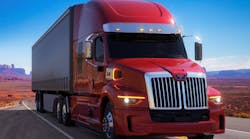Change has become a familiar companion to fleet managers, with everything from emission regulations to diesel fuel prices touched by it.
But that's also true for the trucks themselves, as a variety of pressures, ranging from driver ergonomics to new low-emission engines, has forced almost non-stop changes to chassis, cab, and powertrain designs.
“We're dealing with changes in emissions rules, fuel economy issues, shifting driver profiles and work characteristics — the list goes on,” Bill Dolesh, vp-engineering for AutoCar told me recently. “Yet the trucks we design and build still must be very durable and price competitive; the fleet environment demands it.”
The truck cab, especially for vocation applications such as dump trucks and refuse vehicles, is undergoing a lot of change as drivers and the jobs they must perform are rapidly changing.
“Take refuse trucks,” Dolesh says. “In the past, the driver used to get out of the vehicle and manually empty trash cans. Now, many fleets are moving to completely automated trash pickup, so the driver is expected to sit in the truck cab eight hours a day. That totally changes how we must view the driver and their environment.”
He explains that drivers are taller and bigger than they were a decade ago and spend more time in the cab. Consequently, seats must be more comfortable, the seat belts must be less restrictive, and controls must be easier to reach.
“The driver has to be comfortable, must not strain to reach any controls [while driving] the vehicle, and must have more body movement freedom to help reduce operator fatigue,” Dolesh says. “There's also the safety factor — they need more visibility since they are in the cab a lot more. So we're getting more requests for in-dash rear- and side-camera systems, plus proximity alarms.”
On the engine side, more restrictive pollution rules are leading to new engine designs to accommodate the lower-emissions mandate. “Many of these low-emission diesels produce much more heat,” Dolesh says. “So we are looking at new ways to evacuate heat without impacting vehicle performance, through the use of new cooling system materials, coolant flows, fan time management, etc.”
Then there's the “plug & play” concept that's gaining steam in the vocational market, i.e., how to get body builders and truck OEMs more in synch, so their products can be easily integrated with a minimum of electrical system splicing, for example.
“We're going to be working together much more in the future,” Dolesh says. “The key is to add more features and capability to the truck without adding more wires, more systems to maintain. That's moving us toward multiplexing, using wire bundles to maximize what we can offer in terms of electronics, including better diagnostic capability.”
But all of this must take place without compromising durability and weight. “That's the real trick going forward. Everything we do, from electrical system and engine changes to cab alterations [must be done without affecting] the durability or the weight of the truck,” Dolesh explains. “Adding weight to improve durability, for example, can affect payload and fuel economy — two areas we really can't compromise on. We need to walk a fine line.”
The same can be said of all the extra systems being touted for vocational trucks, such as onboard Internet access and cameras. “We have to make a business case to see if it makes sense to the fleet's bottom line and to ours,” he says. “That's the challenge always posed by change: Is it worth it? That's also the most interesting part about dealing with change, too.”


